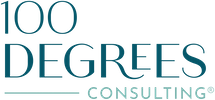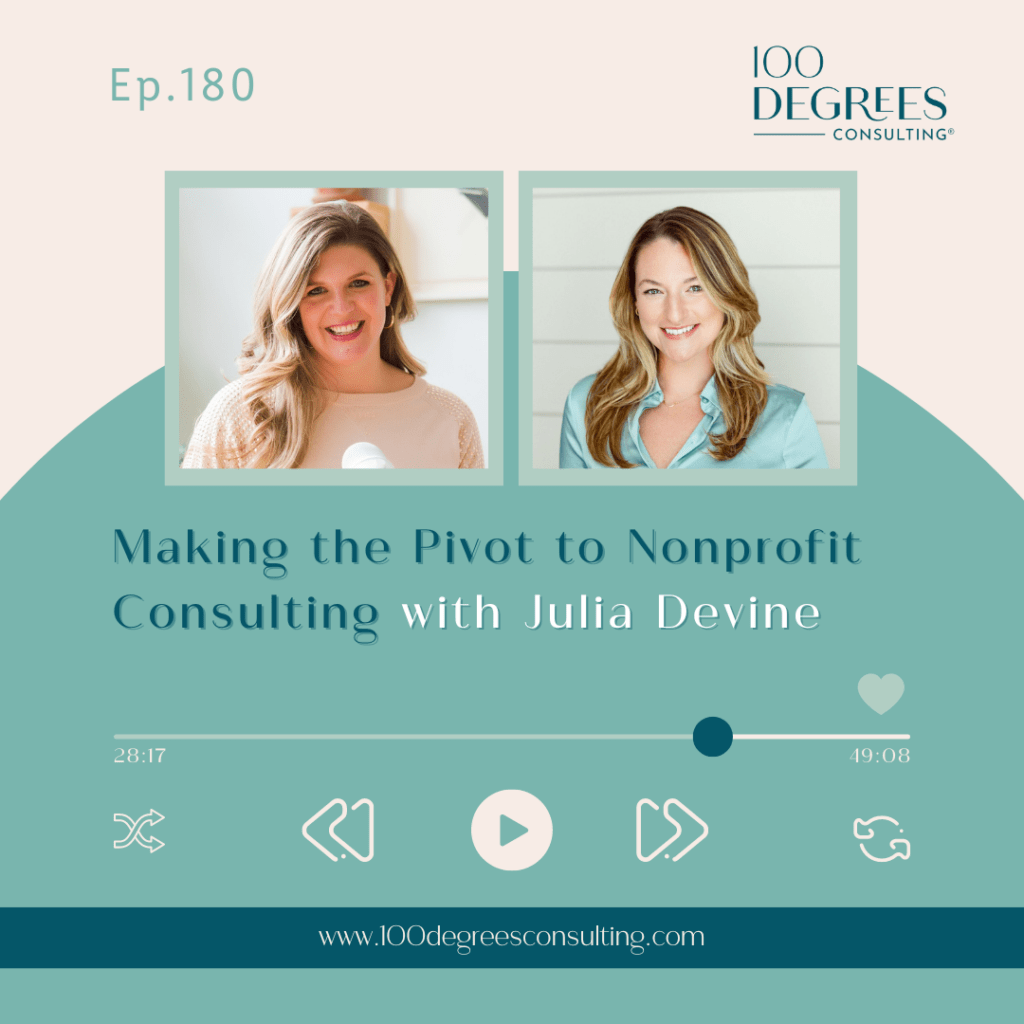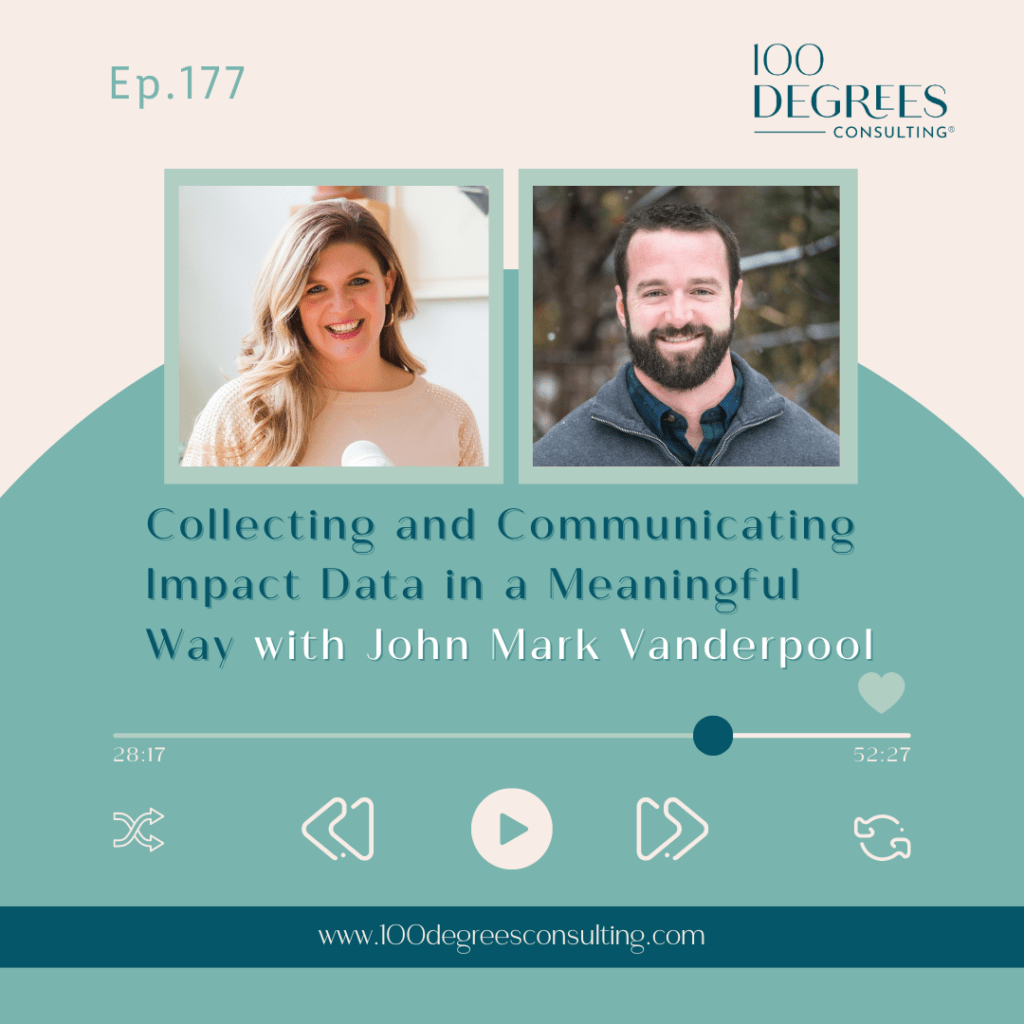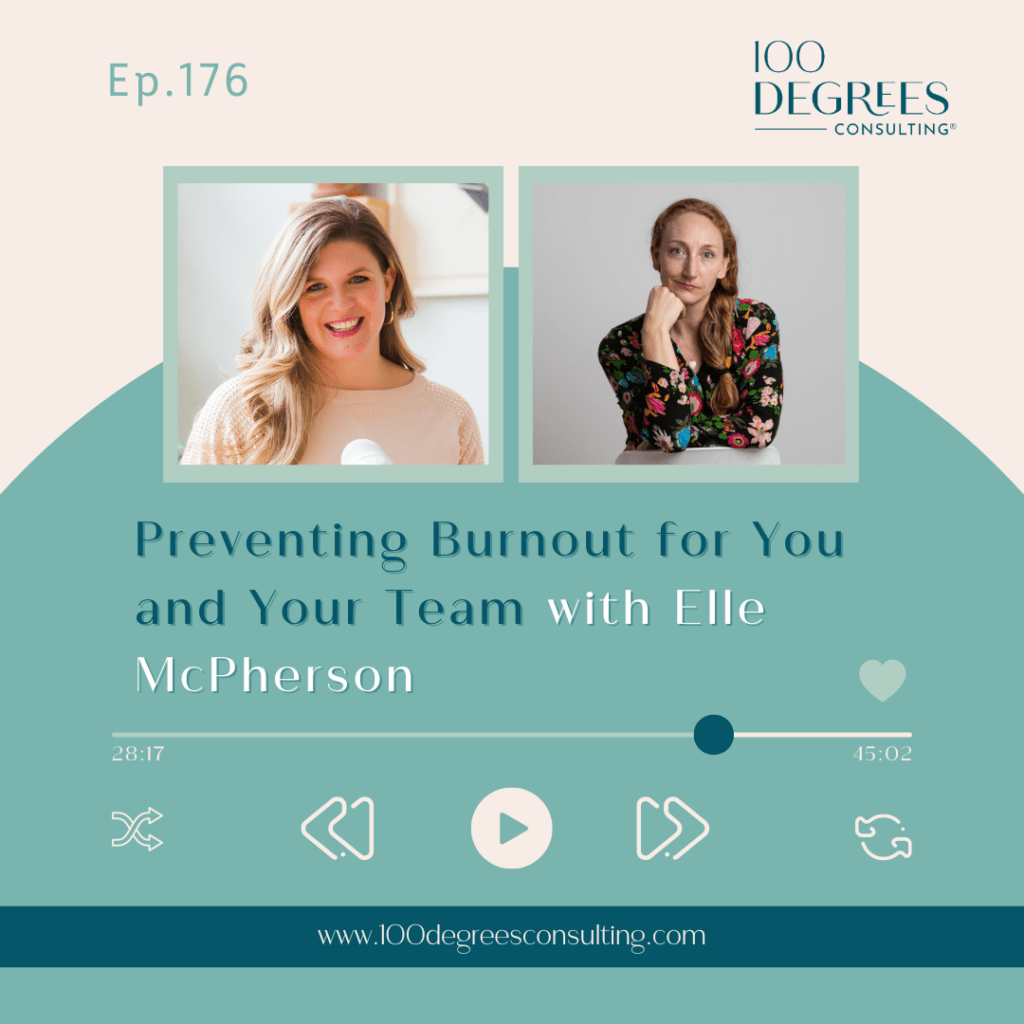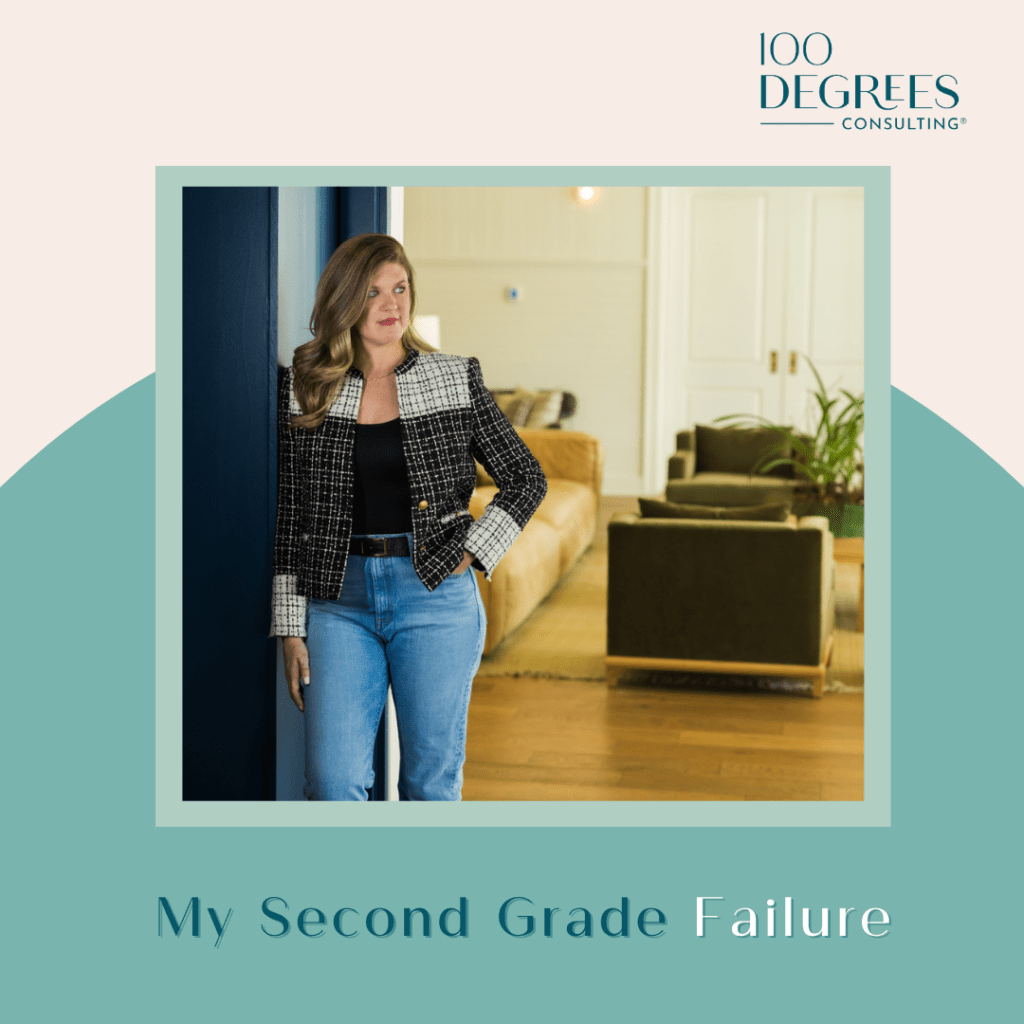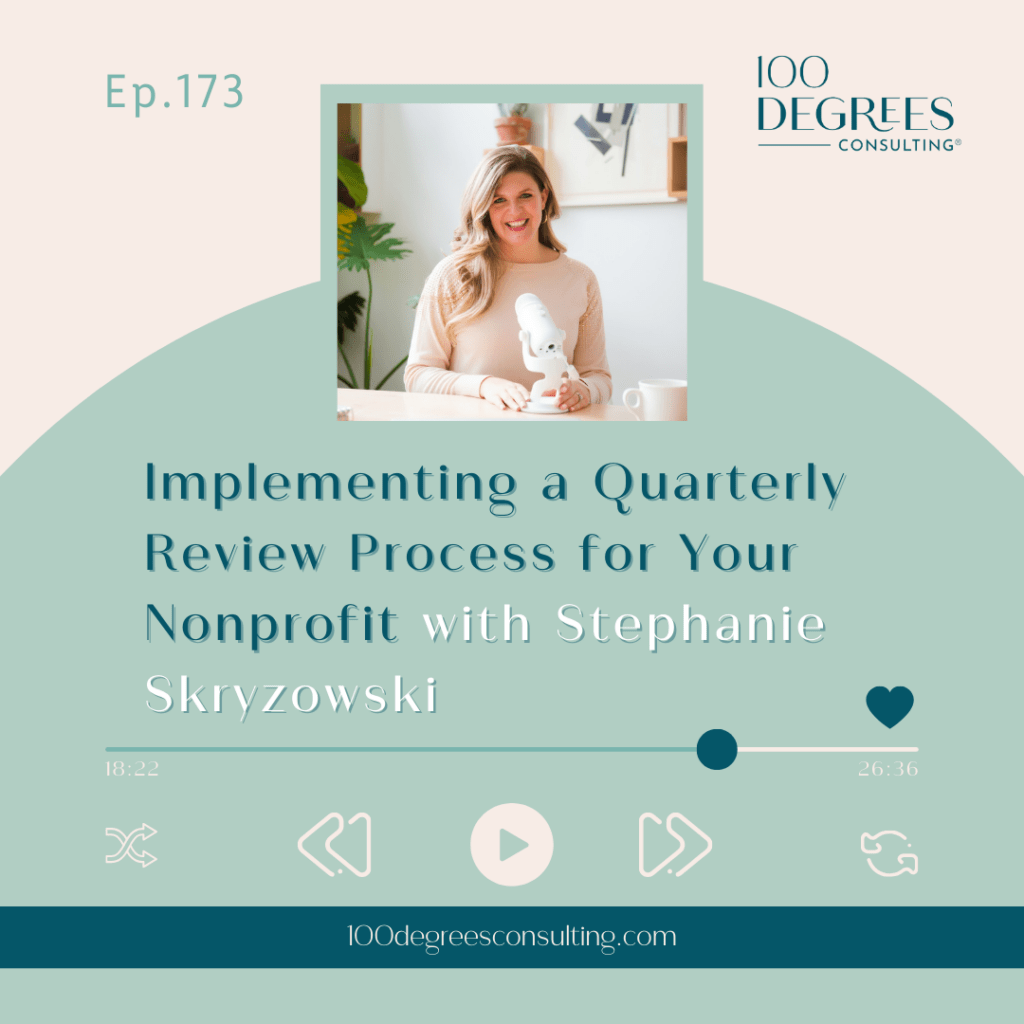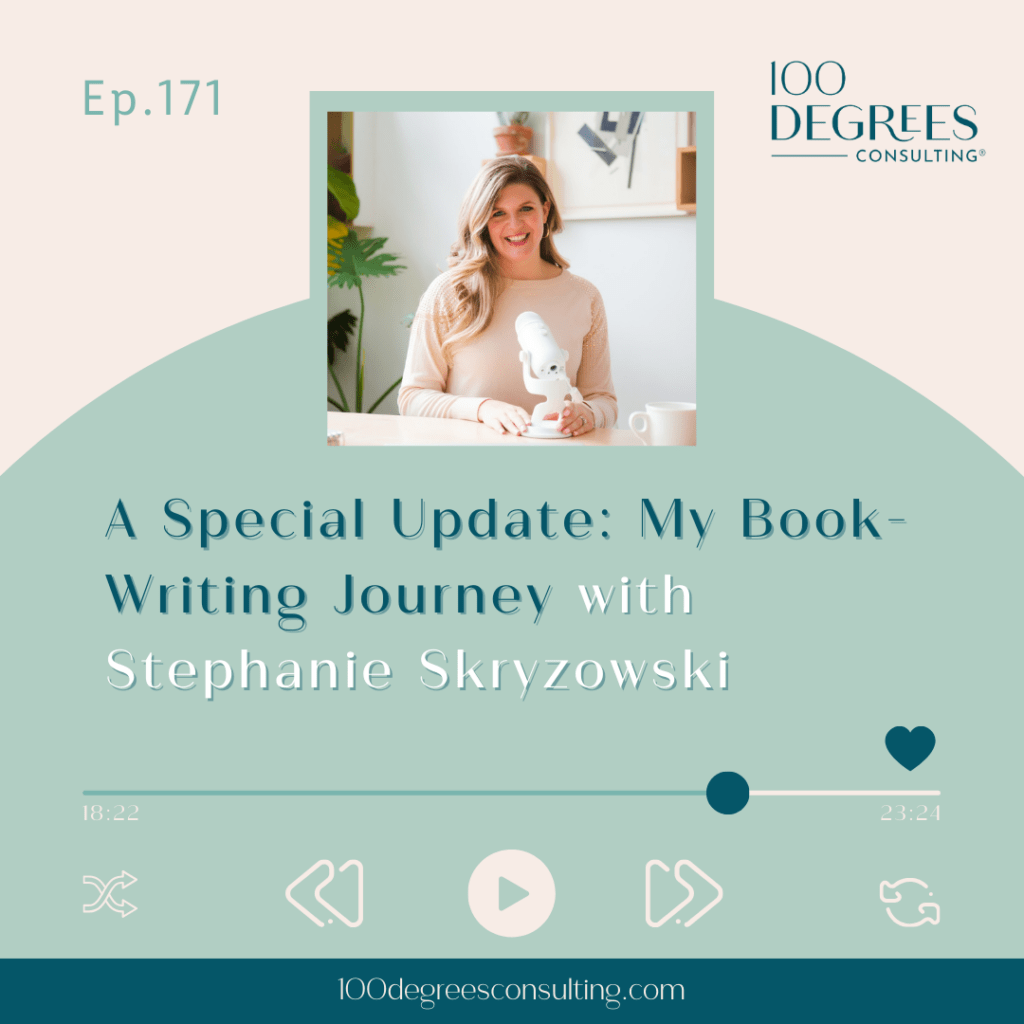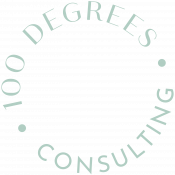Transcript Episode 122 – Using the Agile Framework in Nonprofits with Diane Leonard on The Prosperous Nonprofit
Stephanie Skryzowski: [00:00:00] Hey there. If you’re looking for the 100 degrees of entrepreneurship podcast, you’re in the right place after a hundred amazing episodes, we’re changing things up to serve you the most inspiring content in a fresh new way. Thanks for being here and keep listening.
Welcome to the prosperous nonprofit, the podcast for leaders who are building financially sustainable and impactful nonprofits and changing the world. I’m Stephanie s Kowski, a Chief Financial Officer and founder. Founder and c e O of 100 Degrees Consulting. My personal mission is to empower leaders to better understand their numbers.
To grow their impact and their income. On this show, we talk to people who are leading the nonprofit sector in new, innovative, disruptive, and entrepreneurial ways, creating organizations that fuel their lives, their hearts, and their communities. Let’s dive in.[00:01:00]
Hey everybody. Welcome back to the Prosperous nonprofit. I’m excited you’re here. And of course, I’m excited about our guest today, as I always am. Today, I’m talking to my friend Diane Leonard, and she tells us about Agile and Scrum. So if these sounds like absolutely foreign words, I’m with you. Until I had this conversation with Diane.
So I asked her like, define everything. Explain everything for us. Cause I’ve never heard this before. I don’t really know what it means. But basically it’s an approach to work that was sort of coined in the corporate sector and there’s a set of core values and then Scrum is sort of like the methodology or the framework for doing work.
And really it could be. Any kind of work. And so I’m gonna let Diane explain it cuz she explains it a lot better than I do. And she also has a website with some like amazing resources to help define this. But I think the key thing here is. It’s really a unique approach in the nonprofit sector to, to [00:02:00] doing our work, and she talks about it as she mentions this core, this value of agile about responding to change over following a plan.
And I thought that was really interesting because I feel like the pandemic sort of forced us all to just respond to change over following a plan. And so in that way, I feel like a lot of organizations were very agile. Um, but she really talks about how to sort of instill these agile values, um, in your organization and the work that she does around grant writing as well.
So, It’s a great conversation. Um, but let me tell you a little bit more about my friend Diane H. Leonard is a grant professional, certified, and approved trainer of the Grant Professionals Association. Diane has recently become a certified virtual presenter through speers. She’s also a registered scrum trainer, scrum Master scrum product, and scrum at scale practitioner credentialed by the Agile Education Program.
Powered by Scrum Inc. [00:03:00] Since 2006, Diane and her team have secured more than 104 million in competitive grant awards with the clients of DH Leonard Consulting and grant writing services, and she’s an active member of the Grant Professionals Association when she’s not working with her team on grant applications for clients, Dan can be found in a thousand Islands, which is in New York, out for a run, or drinking a strong cup of coffee and.
We talked about Diane and sort of what I think of when I think of Diane and I told her I think of, um, Grant’s Agile and running until that kind of sums it up. So she is fantastic and super brilliant and without further ado, let’s get into my conversation with Diane.
Hey everybody. Welcome back to the show. I am super excited to be here with my friends Diane Leonard. Diane, welcome.
Diane Leonard: Hi. Thanks, great to be here.
Stephanie Skryzowski: So I would love if you could just tell our listeners a little bit [00:04:00] about who you are and, uh, what your company
Diane Leonard: does. Yeah, so Diane Leonard known first for my professional love for grants, and second for my professional love for all things agile and project management.
Um, I get to call the Thousand Islands home. And I run DH Leonard Consulting and grant writing services. We just turned 17 a few weeks ago. I’m still not quite sure how that happened. I haven’t aged today, so I’m not real sure how that all went down. And you like I legit
Stephanie Skryzowski: haven’t just had to throw that in there like you have not.
Anyway, go on.
Diane Leonard: Thank you. Thank you. Um. But I love to focus on like self-care and not burning out, whether that’s like running, biking, uh, that’s what it is for me, but also for colleagues. So everything we do is about not letting grant stress people out, not letting project management stress people out. So that’s kind of my, my jam, uh, for what you hear me joking about a lot.
Yes, coffee, but time outside, time with dogs, time with whatever to, to [00:05:00] fuel the work.
Stephanie Skryzowski: I love that. I feel like if I had to describe you in like three words, I would say grant’s Agile and running, like, it feels like a very integrated part of your personal brand. And I, I do think that’s so important cuz I’ve often heard myself saying like, I.
I don’t have any hobbies. Like I just work, like my hobbies are working and all things having to do with work. So I love that you really intentionally take care of yourself and do have very strong interests outside of work. I, I like running. I used, I feel like I used to like running more. Anyway. We could talk about running for a while.
Um, Okay, so as you know on the show, we’re really talking about how people in the nonprofit sector are doing things like new and disruptive and innovative ways. And I remember the first time that I met you at nonprofit storytelling conference almost five years ago. At this point. One of the first things that we were talking about was like, have you heard of [00:06:00] Scrum?
And I’m like, Absolutely not. Tell me more. And I know this sort of agile approach is what you do. So tell us about, tell us about what is agile, what is Scrum and how do you apply that work in the nonprofit sector?
Diane Leonard: Alright, big question. Good one, Stephanie. Like, all right, let’s start with something. Easy in the sense that when people ask about Agile and Scrum, a lot of the times people are asking about what that acronym means or like what software I’m talking about.
So we’ll just get it outta the way that I’m not talking about not an acronym for something bigger. It’s not software you have to buy, none of that. Uh, also good news if you aren’t into maybe Pilates or yoga. Talking about Agile is not about our personal flexibility, uh, for our bodies, but rather really it’s our mindset and the way we do work.
So when we think about Agile, there are four values that are present in agile teams, in agile businesses and agile [00:07:00] individuals. And so bringing what really is a for-profit, well-known way of working into the nonprofit sector is different. Um, we can talk about that some more, but, so these are international industry agnostic values.
Really, they’re an umbrella for multiple frameworks, so ways of operationalizing these values. And so Scrum, which you mentioned, cuz Yeah, I’ve been called Scrummy before. I’m okay with it. It’s another label I’ll accept. Um, but Scrum is one of those frameworks that’s under the umbrella of Agile. And so if you say you’re a Scrum team, well that means you’re using the Scrum framework.
But it also means you’re under that umbrella of agile, like those four values, they mean something for you. They are helping your organization or your team to respond to change over following a plan. So that’s how those two things, uh, work together. And the reason then that we do this work in the nonprofit sector.
[00:08:00] Remember, my first professional love is grants. And grants are deadline driven and they’re big and they’re stressful. And I didn’t think they always had to be stressful, but it’s a lot about project management. I. And so I found Scrum almost 10 years ago now, and thought about how we could use that framework and also then learned about the agile values.And it caught on and our clients wanted to know more. And, uh, other nonprofits wanna know more. And it turns out I didn’t know this at the time, but now I’m like, oh, I have examples. Nonprofits do a really good job of being agile. They just don’t know the label. Mm. And so, uh, yeah, I think what’s different is helping nonprofits understand that it’s a label that is available to them if they want, but also that there’s lessons from other teams regardless of industry that can really, uh, play a role in how they consider a new way of doing work.
Stephanie Skryzowski: Interesting. Can you give us like an example of how this sort of framework is operationalized in a nonprofit? Like what does this [00:09:00] actually mean? How does it work?
Diane Leonard: Well, it looks different in each organization. Um, so we host an annual Agile Nonprofits online Summit, totally free event. Welcome you and all your listeners to come join us every fall.
And it’s different nonprofits talking about what Agile in their organization looks like. Mm-hmm. We’ve yet to have an organization tell us exactly the same thing. Mm. Even if they are following the same framework, their answers are slightly different because the framework will use Scrum as our, like our reference point is the framework.
Cause we have so many nonprofit examples. The framework is a lightweight set of rules, but just like if you were to pick up. Uh oh. Okay. Stephanie, what’s like your favorite board game or card game or something with your family? It’s okay if it’s candy land, it’s okay.
Stephanie Skryzowski: Okay. Let’s say favorite card game. Uno.
Diane Leonard: Great. So Uno has a set of rules, right? [00:10:00] There’s some luck in Uno, but also some strategy. Like do you hold the wilds till the end, right? Mm-hmm. I just totally gave away my strategy. Live to you on a podcast. Nevermind, but like that’s a playbook thing. Something that sets you apart from someone else. So what’s happening is that there’s like these lightweight rules and a framework like Scrum, so there’s some consistency then across all the nonprofit teams using it.
But there’s all these areas for playbooks, for creation of what makes them unique. What time do they come together for dailies? Scrum doesn’t say. How do they handle it? If they’re a fully remote team, are they on Google Meet or are they on Zoom or are they on Micro? Doesn’t say. I mean, those are like really tiny logistical type examples, but there’s so much room for interpretation and making it fit within an organizational culture that that’s part of what I think is so unique for, as the nonprofits are considering.
Are we agile, are we not? It’s a [00:11:00] really broad description. And it is more value based than like, what does it actually look like? I think that the consistency across all of them. It has nothing to do with software or tools or any of that, but it really is about how do the nonprofit teams, how do they respond to change over following a plan?
How do they prioritize the individuals that they’re interacting with in their team, in their organization? How do they value that more than what the standard operating procedure or tool tells them to do? Those are the things that are consistent across the nonprofits that are implementing agile ways of working.
Stephanie Skryzowski: And are there certain like triggers or certain changes that happen within an organization or certain projects that sort of trigger wanting to work in this way? Or is it just like a, just a way of, a way of working, um, sort of in general, or is it triggered by something in particular? Does that make sense?
Sure. So
Diane Leonard: [00:12:00] usually it’s brought about by someone, and it could be in finance and programs and development and senior leadership. It’s brought about by someone saying, I would, I think we could maybe do this differently. Do we have to do this the same way we’ve always done it? Or is our communities need different, is our organizational need different something?
Precipitates this idea that it, we could do something differently. I wonder if we changed the way we work, could we get different results? And so it bubbles up from different places, but that is what usually is what’s going to bring about. Whether again, like it’s a day-to-day worker bee. Doing like development acknowledgement letters or like the vice president of program saying, I think it can come from anywhere, but it’s someone in the team, someone working towards a mission and vision is saying, what if we changed this?
Could it be different? And what the this is is different for each of [00:13:00] the stories.
Stephanie Skryzowski: Interesting. I think that there’s often a lot of like. This is how we’ve always done it in organizations, especially those that have been around for a long time. And so I love that there’s this sort of opportunity to think about things differently.
To do things differently. And how do you, like what does, what does your work look like? Are you like, are you the facilitator in the process? Like what does that look like? Like do you need somebody to kind of help shape? What this approach looks like for organizations.
Diane Leonard: Yeah. Okay. Let’s go back to the intro when we were talking about like your brand, right?
Like you’re, you know me for grants and Agile and running. If you don’t mind, I’m gonna like use the running part and like fitness for a moment. Yes. And some people love having a fitness coach. Right. Someone like a health coach, they could call, or some people like being in like a CrossFit bootcamp type thing, and [00:14:00] there’s gonna be a person that tells them what to do with all the things.
Other people love to watch a video on their phone and an app. Other people are totally self-motivated to just put on their sneakers every morning and go, right. So just like when we think about our personal health and how we might wanna move towards that like fitness health goal, when people are thinking about agile, When they’re thinking about a specific framework like Scrum, different people are inspired and then learn and have a different hypothesis and test them in really different ways.
So it’s part of why we have really, it’s more about building a community of practice with different options. So a community of practice than Agile Speak is a group of professionals that can share and learn from each other. So the biggest thing we’re trying to do and making sure people have access to is, oh, you want, you like working out, using your app.
Okay? You might like these little free downloads with a pdf and you might like these little YouTube clips for your self-directed piece. Oh, you like [00:15:00] learning in little bite-sized chunks, but uh, you don’t wanna go trolling through the YouTube channel. Great Agile basics. The two hour class, learn. Process, think and decide what you wanna do next.
Oh, you love credentials. You love signing up for like an eight week boot camp, right? Focusing on your personal, great. We’ll see you for a credential class. Oh, you wanna coach one-on-one? They’re all great options because they’re driven by people wanting to change the way they work. Just the same way. All those fitness options I described could be amazing cause everyone will have a slightly different goal.
So we have a wide range of options. For how we try to make it so that, cuz really what we’re trying to do is help nonprofits be inspired, not by me or my team, but actually by the other nonprofits that are being showcased in the community of practice in those little learn grant summits so that they can see others doing similar things and having success with it and saying, oh, I like the way they did that.
I [00:16:00] could try that. Oh, I liked the way that they approached that. Um, Really finding their own playbook in that way. I
Stephanie Skryzowski: love that aspect of community that you just talked about. I’ve been having like lots of conversations with amazing nonprofit leaders and others that work with nonprofits and community is a theme that just keeps coming up again and again, as you know, a source of.
Um, you know, a source of support and feeling like we are not all, you know, in this by ourselves. We are all in this together. And so I love that you’ve built that, um, sense of community in your work as well. How have you seen that play out in, you know, building up community, bringing people together, and the impact that that has for nonprofit leaders?
Diane Leonard: Well, I think what it does when we think about the community of practice in the agile lens is that. Instead of thinking about like, oh, the broad LinkedIn network or [00:17:00] the group of people that you meet all at the conference or your local community collaborative groups that maybe your United Way brings together, it puts a different lens on what you’re gonna be sharing and learning about together.
And so it’s a space then that an executive director can learn in a very safe, uh, way from maybe that. Development associate or two executive directors could connect and start to talk about things. It, it gives a space to learn only about one thing. There’s so much noise. When we’re trying to think about our communities and our network, so they can come and have one conversation, uh, focused, well, maybe not just one conversation, but have a conversation or a learning moment around Agile and say, oh, you know what?
I, I love reading books. And hey, what’s the best thing that anybody’s read lately, uh, in the agile space? Or, uh, Hey, has anybody seen this free thing that Adam Weisberg’s doing? Uh, his Agiles. Summit and like [00:18:00] share and banter in that space and uh, know that it’s nonprofit focused. Cause I think the one thing that is a risk with Agile is that because it originated in for-profits, nonprofit professionals, rightfully so, can be a little skeptical.
Like is it for-profit explaining to the nonprofits? Love that term by the way. Couldn’t come up with another way to
Stephanie Skryzowski: describe it. Um, it is perfect.
Diane Leonard: Learning from each others as nonprofits, right? That’s why the community is so important, because it’s not somebody at Tesla or somebody at John Deere or some other big corporation telling a nonprofit what to do.
It’s nonprofit sharing what’s working for them within these values, within these frameworks. Um, and that’s what I think is so important about it. Yeah,
Stephanie Skryzowski: I love that. Have you ever had to deal with, I mean, for-profit explaining like that needs to be like tm. Um, have you ever had to [00:19:00] deal with situations where you’re feeling like you have to, or you’re get maybe like getting pushback if you’re like, I have this approach that I think could really work for you.
Do you get pushback like, uh, that’s not gonna work
Diane Leonard: for us? Oh yeah. We’ll just leave it at that. Yep. Oh yeah. Drop the Yeti done. Um, which is why, so having people that are raising their hand and saying, I’m interested, I’m interested in these values. I have an idea about doing a, a different way of working regardless of where it comes from in the organization.
Like that’s a person who’s gonna be excited to learn and try and grow and hypothesize and test things. But like that idea, and this is definitely. It’s a phrase that was existing in a lot of places in business publications, pre pandemic. It’s been pretty much overused everywhere I can think of since then.
But like an agile transformation, we’re gonna go through an agile transformation. Like, oh, that’s great buzz language. It’s delightful. Right? What does that really mean? Mm-hmm. [00:20:00] The idea that if you say we’re going to transform who we are, and like it’s change that’s being forced on team members, up or down, someone is doing something that they did not, uh, self select into.
Mm-hmm. And so, Then we’re dealing with change management and organizational behavior, right? So that happens a lot. Where really well intentioned professionals coming from either direction of the organizational chart want to see change, but not everyone feels comfortable or understands. Um, that’s where the pushback usually happens.
Not everyone’s on the same page yet. Not everyone’s playing from the same sheet of music. They’re not sure what that really means for them or how, like change is scary, right? Change is scary. I have a daughter applying to college. Change is so scary. Definitely in all aspects. Personal, professional, right?
And so like, yes. Yes. Um, that’s why there’s usually pushback, not because people are against the idea of doing things in a better or different [00:21:00] way, but change.
Stephanie Skryzowski: Do you feel a bit clueless when it comes to your nonprofit’s financial health? Numbers aren’t your strong suit and you feel in the dark as to whether or not your organization has the financial foundation to be around for the long haul. Financial health and sustainability is about more than just how much cash you have in the bank.
It could be confusing to know which numbers mean what, so I’ve created the financial health checkup for you. This simple spreadsheet will walk you through five important financial metrics. That will give you a crystal clear picture of how your organization stacks up, and the best part is no math required.
Head over to 100 degrees consulting.com/health to get your financial health checkup.
I know you work with a lot of different organizations with, with your agile work, with your grant work, what are you [00:22:00] seeing like these days? Really? I was gonna say when it comes to like fundraising, but actually more like anything really. What are you seeing are nonprofits doing that is unique, that’s different maybe you haven’t seen before?
Maybe things that are really working in any aspect really of nonprofit management. Have you seen anything lately that’s really interesting that you’re like, oh wow, that’s cool. Haven’t seen that before. Um,
Diane Leonard: Um, countless things more than we probably have time for, but if I were to put ’em thematically together, I think that they are, the things that are cool are things that are different.
Not just like, oh, our mission is different, that it’s never been addressed before, or, The way we’re doing these collaborations, it’s different than what’s ever done before. But seeing groups that say, we, you know what we, we don’t need a big building with four walls that we have to find capital funding to buy and to maintain.
Hmm. What could we do that’s different? Um, gee, the [00:23:00] talent in our rural community is amazing, but wouldn’t it be better if we actually spanned two rural communities because, We have maybe two smaller offices instead of just one big one, like structural, things like that. No longer being in the way of achieving a mission or vision, I would say is thematically the coolest thing to watch happen.
And I’m a like a glass half full, silver lining sort of person. Um, to me that’s a, that’s a positive silver lining of the pandemic. It helped organizations think differently. I have these little postcards that I carry around with me everywhere I go. Mm-hmm. Right? I’m that person. Um, but before the pandemic, I would say in a nonprofit setting, do any of you think you’re agile in your work, in your team, in your organization?
And maybe I’d get a, a hand or two, but since the pandemic happened, I can ask that question and I’ll probably get more hands. But if I ask it in a slightly different way and I say, [00:24:00] can you give me at least one example? Of how your organization responded to change over following a plan in the last three years, every hand in the room goes up, Uhhuh, and sometimes I’ll flip it and I’ll be like, okay, can, can you give me only 10?
Right? Like, stop, stop telling me anymore, right? Cuz they can list dozens and dozens of ways. And all of a sudden people realize that like, oh, we’re so super agile. Yes, yes you are. And it’s really cool to see, um, them acknowledged. That’s a really positive thing.
Stephanie Skryzowski: I love that. Yeah, and I mean even if it was forced upon us, which I feel like it was to a degree.
Mm-hmm. The fact that, you know, they recognize that, I would imagine that is sort of a door open to talking about this sort of agile approach that I think is really interesting. That’s so cool. I love that. Awesome. Okay. Tell us about your, I wanna hear a little bit about your grant work, because I know that’s another big piece of your [00:25:00] business and what you do and again, of, of who you are.
In my eyes, those, those three things, you’re much more than that. But I do think of grants a lot. So what sort of piece of the grant process, cause I know there’s lots of pieces and lots of different people, um, in that process. What, what does your company do?
Diane Leonard: So we’re a full service grant, uh, writing firm.
We’re focused on the pre-award. So to your point, right, we are not a grant management. Services term, we do all the things before we do the research. The forecasting grant readiness, um, yes. The writing, uh, collaborative partner facilitation in advance of sitting down to write the big things. That’s the work that really gets us excited.
We, we refer to it as the grant life cycle. There’s five key elements, and the point is just like a water cycle, uh, right. It’s always going, never stops. And the idea that grants don’t ever stop and you need to make sure you pay attention to [00:26:00] all the elements. It’s not just writing. Um, to us, that’s what helps keep grants from being unduly stressful.
And so we have an agile approach to grant seeking. So that’s how they came to be to me. They’re like peanut butter and jelly in terms of how well they go together. Or maybe, I guess you wanna say peanut butter and Nutella or everybody can have their choice. Peanut butter and fluff, clearly all children, right?
But they could go so well together. Um, that for us, writing grants in an iterative way that is focused on feedback from the different stakeholders. It’s our natural way of working now. We can’t imagine doing it any other way. So not to put it back into the Agile column, cause you just said Diane, talk about the grant stuff.
But that’s what makes it so that our applications go out the door faster, which therefore takes the stress out of the grants for folks worried about the submission and the 11:59 PM deadlines that, I don’t know why grants.gov even gives us the [00:27:00] option. It’s just mean, right? Um, but that’s part of what enables the grant process to be less stressful, more sustainable, more successful, quite frankly, right?
What does everybody want, want the money to do the great work? If they could just drop the stress of the grants. So we do everything we can to help take the stress out of the grant process.
Stephanie Skryzowski: Mm, I love that because I, you know, I’m having these conversations with a lot of nonprofit leaders and everything that we’re talking about comes back to like, The people and the team and taking care of our people, and that is like the work that you’re, you’re taking care of the people through the process and making that a, a smooth process so that it is less stressful.
When you mentioned like the sort of water cycle that it’s like never ending, um, and comparing that to the grant cycle, do you find that, like, you know, if you sort of have the process down and you’re handling it in a really sustainable way, does that then perpetuate like [00:28:00] additional funding? Like is it sort of ongoing like that?
Yeah. I’ll, I’ll stop there. Is it
Diane Leonard: ongoing with that? Yeah. Yeah. It, it totally is. Um, cuz the way it reads, like when we pull up our image on it at the 12 o’clock position, like the top of the clock, it’s grant readiness and then it’s research, and then it’s relationships, and then it’s writing. And the last element is reporting.
Whether it’s financial or programmatic right now, I can tell you’re excited. You’re like, Ooh, we’re talking about finance duh numbers, right? But you and your colleagues and all those you support, right? You just became an important part of the life cycle because that is going to be what sets you up for success the next time around.
Whether with the same specific funder or with another funder in the community that heard good things about what a great grantee you were, that’s setting it up for more success in the future. Um, so yeah, and then you, you get to start all over again. It is a bit like a hamster wheel, but I like the lifecycle language a whole lot more than like the hamster wheel of grants.
Stephanie Skryzowski: Yes. That has a [00:29:00] more pleasant image to it. Yes, for sure. I love that. Well, I think that just goes back to like, okay, if we do things right the first time and we. Take the time and energy that we need to like make things right. It’s going to perpetuate continuous growth and further the work that we wanna do, potentially with less effort in the future, right?
Like if we kind of get the ball rolling, then it continues with maybe like a little less push on the wheel to make it, to make it turn, I would think. Maybe
Diane Leonard: that’s not right. No, a hundred percent. A hundred percent. The more that we kind of flex that muscle of the best practices and how we forecast things or how we work with collaborative partners, uh, how we set ourselves up for success in our, like our writing objectives for then our reporting to be successful.
Those are all things that take practice and time for each of us as a person and as a team. And, uh, yeah, you get stronger overall.
Stephanie Skryzowski: And it feels like, um, I know a lot of times we’re in very much a [00:30:00] reactive mode where we’re reacting to outside situations or we’re, we’re reacting to things that. Need to happen versus being more proactive.
And it really sounds like you approach both, you know, your, like the agile approach to the grant writing work and the work that you do in a much more proactive manner. And is that, I mean, do, do you feel that way? Is that something that you’re trying to bring into the organizations that you work with as well?
Like again, stop. Stop being so reactive and being more proactive.
Diane Leonard: Yes. Big. Yes. 100%. Yes. Ok. Having been a, so I actually started my career as a grant maker, and so I say this with respect, all the respect in the world. Mm-hmm. For other grant makers in all sorts of different agencies. But grant makers have a goal to use money to achieve a mission.
And they’re then looking to their funding partners, and sometimes we’ll make requests related to achieving their goal As the funder, that puts a lot of stress and strain on the grant [00:31:00] seeker, and so well-intentioned grant makers may call a nonprofit and be like, okay, so for us to consider this $25,000 grant that we’ve been talking about, I need this from you tomorrow because we meet in two days.
Fill in funder name in this story. It’s happened to just about any nonprofit, and like I said, there’s, it’s a well-intentioned grant maker asking this thing, but so that’s super reactive for an organization, and I’m not sure that there’s an answer to make that go away for everyone completely. So if that’s the only type of reactive scenario we have to address.
In our grant seeking world. I’d say that’s a win. And so that’s why you’re right. We spend all this time being proactive. What are we thinking for deadlines? What do we think might open at the federal level that we wanna do? Ooh, this particular foundation opened in March the last three years, but they’re gonna open in March again this year.
Why wait for it to be March 1st? Let’s start planning in February, right? How can we use, I mean, I have a magic eight ball here on my desk [00:32:00] behind me, but how can we use like our grant crystal ball? To come up with a plan so that the reactive part that is left are those well-intentioned funder moments. And they’ll happen a few times throughout the year and they might take a little bit of super fast planning on the team’s part, but it isn’t the constant cadence and rhythm of the team.
Cause that’s what creates such high levels of burnout in the grant sector. So we wanna minimize those reactive moments because one, it protects us as people in the teams, and two, it is. Much more successful from the revenue perspective for the organizations.
Stephanie Skryzowski: Yeah, I talk about that a lot when it comes to the financial side of things as well, like making sure that we have a solid monthly close routine where our books are done by the 15th of every month, so that we always have like solid financial reports.
We do forecasting, so we have like, A solid picture of what the financials look like for the year. Um, so again, we’re ready at the drop [00:33:00] of a hat to answer requests. So again, it it protects the people. I, um, yeah, I didn’t really think about that in that, like, in that way, thinking about, okay, by doing that, by setting up those foundations and those really good systems and processes, you are protecting people from burnout and from overwhelm by being able to be more proactive like that.
So, I like that a lot. You mentioned at the beginning how like intentional you are around taking care of yourself, taking care of your team. Um, I know you do have a team of other people that work for you, so what does, um, what does that look like? What do you do to be really intentional about
Diane Leonard: that? Well, we are a unique team.
Many of us have standing in treadmill, desks, some homemade treadmill desks. I love it. Doing 10 years ago, uh, we have a wellness channel in Slack where we’ll share different things. Like, oh, it’s 40 degrees in far, far, far upstate New York. In February, I’m [00:34:00] taking a 10 minute walk with the dog between lunch, not, you know what, maybe that just happened the other day.
Maybe that’s why it’s fresh in, in my mind I was like, what is this weather? Um, but so we. Constantly are testing and trying other ways of supporting each other because we’re fully remote. We were remote before remote was cool. We’re across all these different timelines. Mm-hmm. I know you get this too, right?
And you Yep. But it’s a common thread that whether we’re having like a hydration challenge in Slack, Did you meet your personal goal for water consumption for the day or, I love that. Whether it’s talking about, you know, okay, how’s everybody doing? Did everyone remember to stand up from all their typing enough today?
Um, we’ll just, we try to have some fun with it. Because self-care looks different for all of us, but we each as team members in a firm that focuses on grants so heavily, we recognize our risk for burnout is so high that this is the way we can support each other in being our best selves and, uh, hopefully avoiding burnout.
Stephanie Skryzowski: Love the Wellness Channel [00:35:00] in Slack. Um, I feel like I need to start one in our Slack channel too. I just, I like that you like talk about it. I feel like I haven’t worked for, and I haven’t worked inside of a nonprofit in a while now. Um, but I feel like. Maybe it was said that that was something that was important.
But like, nobody ever talked about that cuz it was all just, we were all just working, so nobody ever talked about it. So I love that you kind of bring that front and center and living out that sort of value by talking about it and you know, and sharing what you’re doing to take care of yourself and protect yourself.
Amazing. So I like to ask this question of, um, this is my last question for you. I like to ask this question of all of our guests, but what does a prosperous nonprofit look like to you? Uhhuh? Yep.
Diane Leonard: And, uh, I, I thought that question was coming. I’ve heard you ask that before, and I’m like, and, and what does it look like?
Because no surprise, it’s not. One, like I don’t close my eyes and have this image of this [00:36:00] perfect, prosperous nonprofit rather. Um, when I close my eyes and I think about that question, I see literally like all these different faces, almost yearbook style is like what’s in my mind. And I’m thinking about these passionate nonprofit professionals in all different roles in their organization who are trying to create amazing change in their communities.
And that they’re trying to do the best they can without a lot of resources. All organizations feel that way, right? So a prosperous nonprofit, to me is an organization that is the structure in which individuals like that are empowered to thrive. Because it’s not mission specific for what would make a prosperous nonprofit.
And it’s not about budget size. It could be 250,000, it could be 2.5 or 20.5, right? Mm-hmm. But to me, a prosperous nonprofit is an organization. Maybe they don’t even have real walls. They could be fully remote to, and I that would be fine, but like the [00:37:00] organization that has the structure to say, We are going to do amazing things together, and I empower you to help create those amazing things with us, uh, and to try and, you know, create our mark on the world.
Try and create change. So that to me is what our prosperous nonprofits. Would look like and yet No, you’re right. I should also add that they, that they embrace agile values, whether they use the label or not. I had to say it had to say it.
Stephanie Skryzowski: I love that. Well, I feel like it wouldn’t be authentic to you if you didn’t say it, so I love that.
But I love the idea of having an empowered. Team, because I feel like we’ve all probably experienced those organizations where the team is not empowered at all to be part of any decision making or any change. And so I think that’s amazing and I, I definitely agree with you on there. Awesome. Well, Diane, where can people find you if they want to learn more about your work with grant writing or your work with Agile?
Where, where can we find you? Yeah. [00:38:00]
Diane Leonard: Oh, for a run a lot. Oh no, sorry. You didn’t mean more actually
Stephanie Skryzowski: Find in the Thousand Islands New York.
Diane Leonard: Oh, no. Oh, you’re like, oh, I’m so funny. I’m so predictable. Um, so our website is dh leonard consulting.com and that’ll, you can from there, get right over to agile and nonprofits.com.
Uh, or you can start in the other direction, agile and nonprofits, and. Com and head over to the, the grant side of the house. But, uh, we’re, we’re on all the socials and, uh, yeah, always looking for folks to, to chat with about it. So would, would love to connect with folks.
Stephanie Skryzowski: Awesome. And if you feel like I just clicked over to the link that you shared with us, um, where on the Agile in Nonprofits website, you have a getting started with Scrum and a glossary of scrum guide.
And so if you listen to this and you’re like, I am very intrigued, but I’m also terrified because this is foreign language. I dunno where to. Start. It sounds like Diane has some very good resources over on her website. Is that where you would recommend for people to [00:39:00] start? I’m like, okay, start. Perfect.
Diane Leonard: It’s a very good place to start.
Stephanie Skryzowski: Amazing. Okay. Awesome. Well, thank you so much. I’m just so excited that we got the chance to talk, and again, I think you’re doing really interesting and unique things with your agile work in nonprofits and everybody can learn more about it. Agile in nonprofits.com. So Diane, thank you so much for being here.
Thanks for having
Diane Leonard: me, Stephanie.
Stephanie Skryzowski: Before you go, I just wanna thank you for being here. To access our show notes and bonus content, visit 100 degrees podcast.com. That’s 100 degrees podcast.com, and I’ll see you next time.
